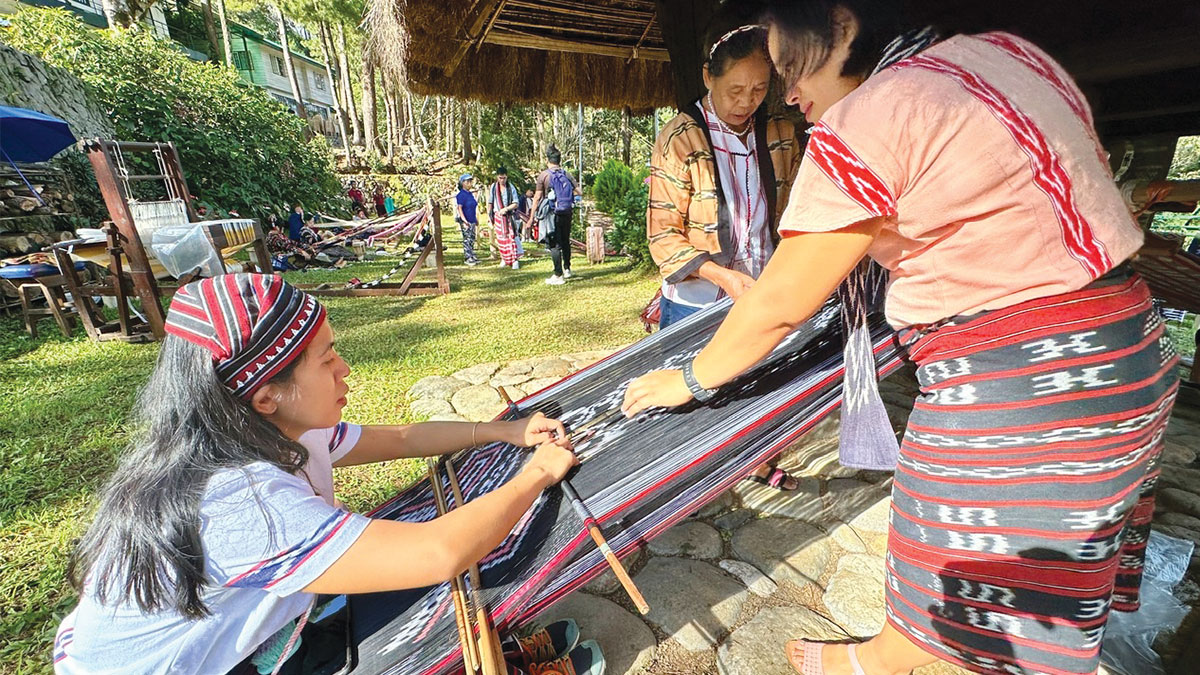
OPENING MARKETS Traditional woven garments continue to serve the Cordillera’s ritual life but modern versions of “ikat” patterns and colors helped put the craft in the domestic and global markets, thanks to the late Narda Capuyan. Since her passing, her daughter Lucia has kept her brand Narda’s alive while granddaughter Madeleine has been learning the trade. —Photos by Joel Arthur Tibaldo
BAGUIO CITY, Philippines — Fashion enthusiasts would flock to the summer capital in the late 1970s through the 1990s to shop for “ikat” garments, bags and home décor crafted by Narda’s—arguably the first Cordillera brand to captivate both Metro Manila’s elite and an international audience.
The brand was founded by Narda Capuyan, a former family planning nurse who recognized the commercial potential of traditional Cordillera textiles.
She employed local weavers to create vibrant, handcrafted pieces, transforming the humble art of weaving—common in the quiet towns of the Cordillera region—into a thriving business with modern appeal.
READ: Cordillera weaver’s tapestry bags int’l award
Capuyan’s business acumen played a pivotal role in reviving and spotlighting Cordillera “ikat” (a method of dyeing or coloring fabric in patterns before it is woven) at a time when traditional backstrap and loom weaving were on the brink of fading away.
Her daughter, Lucia Capuyan Catanes, highlighted this legacy during the World Ikat Textiles Symposium held in Baguio City this week.
Capuyan grew up in the Mountain Province town of Besao, where woven blankets and other materials were day-to-day utilitarian items that were also ritual artifacts of some importance.
“My mother’s familiarity with weaving in the region developed over time … Knowing how to weave, although not always by sitting at the loom, made her appreciate the difficult and laborious process of loom weaving,” Catanes said.
According to Catanes, Narda’s initially had a niche market as “pasalubong” (gift item), but its uniquely vivid ikat colors and patterns drew the spotlight abroad when foreign buyers began importing her “chic and fashionable heirloom items,” she said.
But to expand the brand, Capuyan also practiced what environmental activists now promote to combat climate change: recycling and upcycling. This made her a sustainable resource practitioner way before it had become a movement, said Catanes.
As a child, Catanes said she was sometimes irritated by her mother’s catchphrase: “Kailala” (Kankanaey for “what a waste”).
PROUDLY LOCAL Narda’s products, now carrying designs made by daughter Lucia, are on display at a bazaar during the World Ikat Textiles Symposium in Baguio City this week. —Neil Clark Ongchangco
“My mother in the early years of the business found a factory that made gloves, socks and underwear [and threw out] excess items, excess yarn and trimmings … [along with] cones, cardboard, plastic sheets and more,” Catanes said, so Capuyan bought them and sorted out the raw materials she could reuse.
Recycling, upcycling
Capuyan encouraged the women in the community to unravel discarded gloves, transforming them back into their original yarn, which was then used to weave colorful blankets, Catanes explained.
Even the elastic trimmings from underwear, referred to as “jersey,” were repurposed —cut and shaped into components for bags, floor rugs and wall hangings, Catanes added.
Capuyan later discovered Litton Mills, a Metro Manila-based denim factory, which produced waste materials such as denim selvedges (finished edges that do not fray) and unused yarns known as “slashers” (blue cotton threads). These byproducts were creatively repurposed to craft bags and rugs, Catanes said.
“In the 1980s, the manager of a leather manufacturer learned about how Mama was good at coming up with products out of ‘basura’ (trash). She invited [my mother] to sort through their waste, and Mama produced woven leather [bags and décor] by cutting and sometimes pasting the leather together,” she said.
Yarn scraps deemed too short for the loom are repurposed as stuffing for pillows or upholstery.
Even fabric scraps, or “retaso,” find new purpose, being transformed into quilts and appliqué wall décor, Catanes said.
FASHION Narda’s is arguably the first Cordillera textile brand that has drawn global attention. Its fashion line was showcased along with other indigenous garments in the region during the World Ikat Textiles Symposium this week.
Capuyan died in 2016, but her frugality and creativity still guide the business today, Catanes said.
Narda’s, she said, now produces ecobags by restyling flour sacks at her bakery with “trimming patchworks.”
Passion, family
Capuyan’s passion for ikat was ignited in the 1970s by her friend, US Peace Corps Volunteer Ellen Schatsneider, who introduced her to the art of tie-dyeing fabrics.
“My [20-year-old] daughter Madeleine has taken an interest in natural dyes,” Catanes said, adding that her daughter has been tagging along whenever she attends workshops and symposiums.
Madeleine told the Inquirer that she had first-hand exposure to ikat production at the age of 13.
Catanes said in 2016, they launched Narda’s Naturals, which was the brand’s eco-friendly line of products that utilizes resources like a mahogany tree farm planted decades ago by her father, Wilson, at the family’s Winaca Ecological Village in Tublay town at Benguet. Narda’s workplace has relocated from its original factory in te Benguet capital town La Trinidad to Winaca.
“Ikat was and will always be part of my heritage. As a child, tying rubber strands on the warp [of a loom] was play,” Catanes said, noting that she has since taken up the task of providing livelihood to Cordillera women, many of them mothers, whose traditional weaving skills shape their identity.

